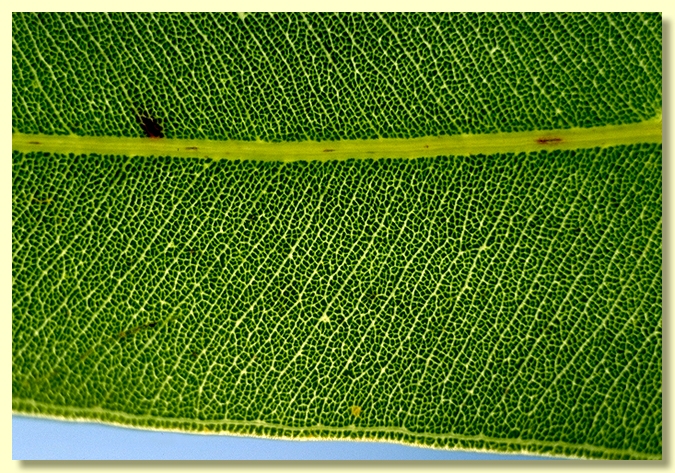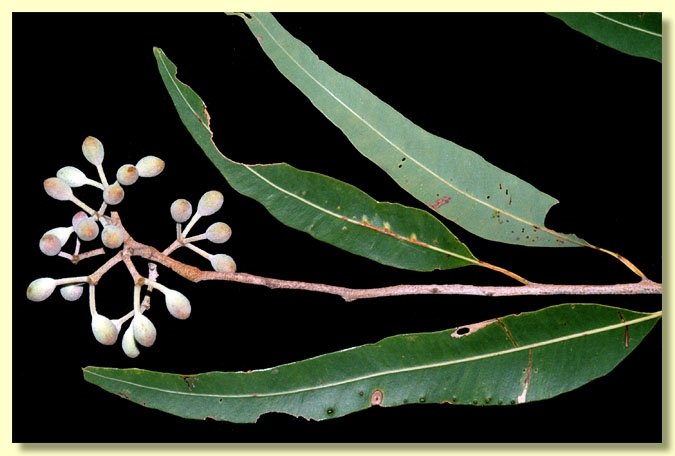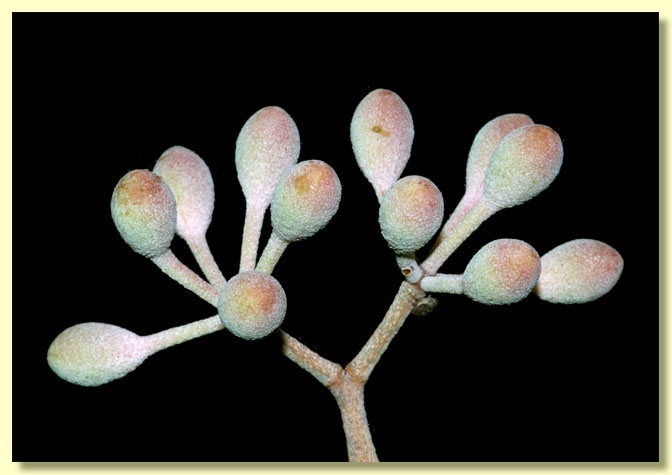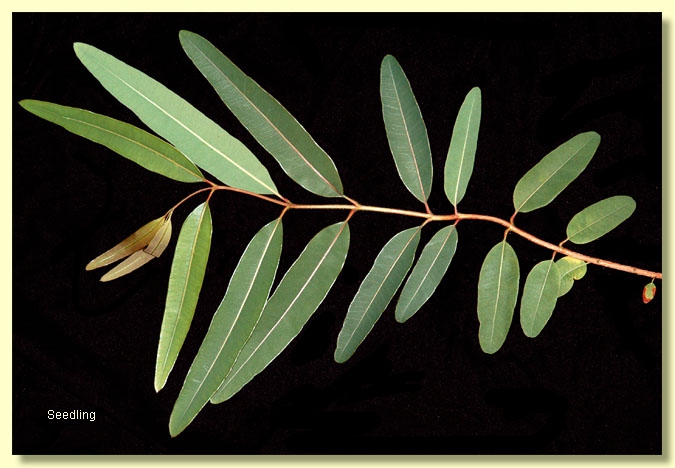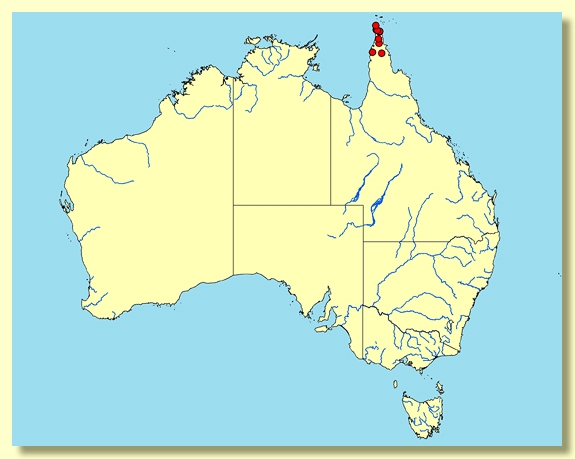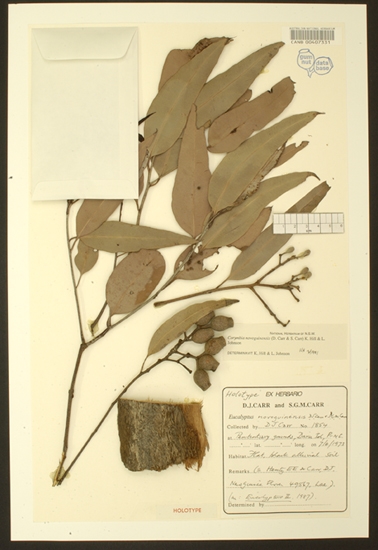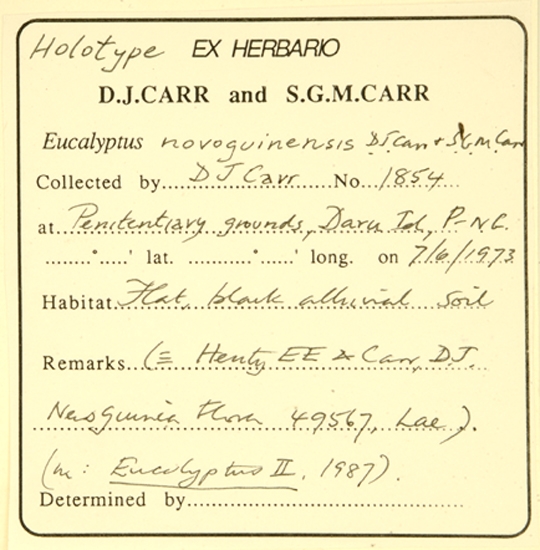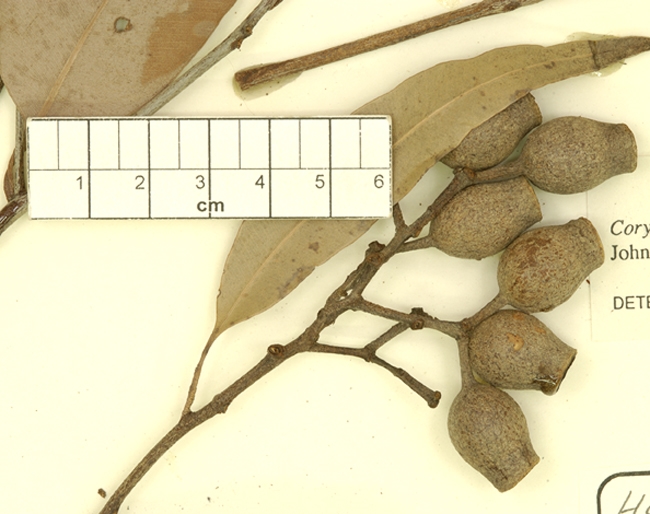Corymbia | Rufaria
Euclid - Online edition
Corymbia novoguinensis
Corymbia novoguinensis (D.J.Carr & S.G.M.Carr) K.D.Hill & L.A.S.Johnson, Telopea 6: 257 (1995).
Tree to 25 m tall. Forming a lignotuber.
Bark rough to the small branches, vertically fissured, flaky and box-type or thinly tessellated, crumbly, grey-brown over red-brown.
Branchlets smooth (glabrous); elongated oil bodies sometimes present in the pith.
Juvenile growth (coppice or field seedlings to 50 cm): not seen.
Adult leaves alternate, petioles 1.5–2.5 cm long; blade lanceolate, 10–21 cm long, 1.2–3.5 cm wide, base tapering to petiole, margin entire, apex pointed, discolorous, glossy, green, smooth, side-veins greater than 45° to midrib, reticulation dense to very dense, intramarginal vein present and close to margin, oil glands usually visible, island, one per areole, sometimes obscure.
Inflorescence terminal compound, peduncles 0.7–1.6(2.6) cm long, buds 7 per umbel, pedicels 0.4–1.8 cm long. Mature buds obovoid to pyriform, plump, 1.1–1.2 cm long, 0.6–0.7 cm wide, very scurfy (whitish scaly surface due to fragmenting rubber cuticle), scar absent (both opercula shed together at flowering), operculum shallowly rounded to conical, stamens inflexed, all fertile, anthers oblong, dorsifixed, versatile, dehiscing by longitudinal slits, style long and straight, stigma blunt and papillose at least around the margin, locules 4, the placentae each with ca 7 ovule rows or ovules not arranged in clear rows. Flowers creamy white.
Fruit pedicellate (pedicels 0.4–1.8 cm long), urn-shaped to barrel-shaped contracted slightly in upper part with the rim slightly flared, 1.7–2.4(3) cm long, 1.1–1.5(2) cm wide, always longer than wide with length 1.3 to 1.7 times the width, smooth or scurfy, disc descending vertically, valves 4, enclosed.
Seeds brown, 8–10 mm long, ellipsoidal with terminal wing, hilum subterminal.
Cultivated seedlings (measured at ca node 10): cotyledons large, reniform; stems rounded in cross-section, setose with bristle-glands for at least 12 internodes; leaves always shortly petiolate (to 0.8 cm), opposite for at least 12 nodes, narrowly oblong to elliptical then lanceolate, 9.5–19 cm long, 1.5–3.5 cm wide, base tapering to petiole, relatively thick-textured, discolorous, mid-green, dull until ca node 6–7 then slightly glossy on upperside, setose on lower side until ca node 8–9 then glabrous.
Flowering has been recorded in August.
Tree of monsoonal far northern Queensland, some islands in Torres Strait, Papua New Guinea and West Papua. In Australia it occurs east of Weipa and sporadically in suitable habitat to the tip of Cape York Peninsula, and Horn Island, Daru Island and Hammond Island. Preferred habitat is well-watered coastal lowlands, and the species has been recorded growing at the edge of mangroves, at the edge of rainforest, in open grassy woodland with Carbeen (Corymbia tessellaris), behind beach scrub, and Melaleuca swamp; soils are not often noted, but black soil and black alluvial soil have been noted as well as poorly drained clay. Corymbia novoguinensis has rough, fissured, thinly persistent grey-brown bark throughout, a crown of glossy green leaves that are paler on the underside, conspicuously white-scurfy buds that become quite plump when mature and fruit that have a slight neck and are never more than 1.7 times as long as wide. Reliable collections of juvenile growth have not been made, so this feature remains unknown.
C. novoguinensis is one of a group of species characterised by scurfy buds, discolorous adult leaves and rough bark that extends to the small branches. Within this group C. polycarpa differs in having much narrower buds on shorter pedicels and fruit being narrowly barrel-shaped and much longer than wide; C. clarksoniana has urceolate fruit and less scurfy buds; C. plena has more sub-globular buds and stout fruit with a thicker rim and occurs much further to the south; whilst C. ligans has slightly smaller fruit and narrower crown leaves (but with some overlap in dimensions) and also occurs further south. See table below for fruit comparison for these related species
Within or near the natural range of C. novoguinensis, other species that may be confused are: C. stockeri subsp. peninsularis, which differs in having smooth, not scurfy, buds, slightly smaller and more urceolate fruit (but with some overlap in dimensions) and has smooth-barked branches; C. nesophila, which has smooth buds and smaller fruit.
This table shows that fruit shape rather than dimensions is the best guide to these four related species:
Species
Fruit shape
Fruit length cm
Fruit width cm
Length: width ratio
clarksoniana
urn-shaped
1.2–2.5
0.9–1.6
1.1 to 1.8
ligans
elongated barrel-shaped, tapering distally, sometimes slightly constricted below the rim
1.1–2
0.7–1.2
1.4 to 1.9
novoguinensis
urn-shaped to barrel-shaped, contracted slightly in upper part with the rim slightly flared
1.7–2.4(3)
1.1–1.5(2)
1.3 to 1.7
polycarpa
elongated barrel-shaped
1.5–3.5
0.8–1.6
1.6 to 2.1
MORE ABOUT CORYMBIA
MORE ABOUT RED BLOODWOODS
Corymbia novoguinensis: Latin novo, new, and Latinized guinea, referring to Papua New Guinea, where the type specimen of this species was collected.



